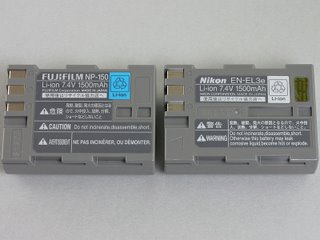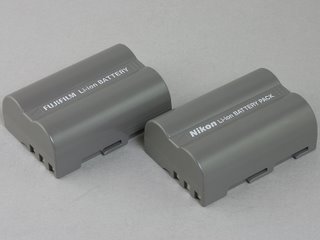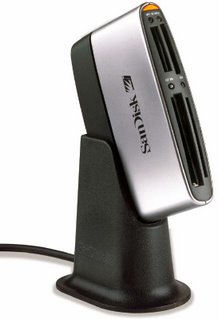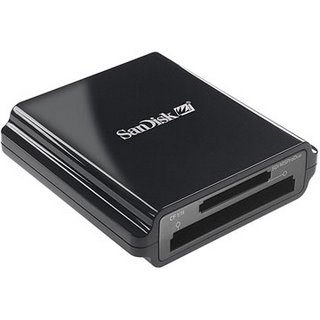Why Did Fujifilm Do This?
The upcoming Fujifilm S5 Pro is due to be released around the end of January 2007. Based on the D200 body, it uses a D200 battery--sort of. Instead, Fujifilm engineered the camera so that it will only work with the Fujifilm version of the D200 battery. Nikon calls their battery the EN-EL3e, while Fujifilm calls their battery the NP-150. Both are 7.4 volts and 1500 mAh batteries.Physically, the batteries almost identical. Take a look:


As you can see, the batteries look virtually identical, with the exception of the shorter notch on the Fujifilm version of the battery. I have to wonder whether or not there's a switch in the Fujifilm S5 Pro that can sense whether the notch is there; if so, that may be the key difference between the batteries and not the internal chip of the battery. Probably one of hte first things I'll do will be to inspect the battery compartment of the S5 Pro.
So why did Fujifilm do this? Apparently, it was just to get some battery sales--a lousy reason. Many potential Fujifilm S5 Pro buyers are already users of the Nikon D200 and battery compatibility would have been a great impetus for D200 users to get an S5 Pro as a second camera. It's not known if the Fujifilm battery will work in the D200. A check of my D200 compartment shows no switch there to correspond to the notch, so it's possible, unless the difference is the internal battery chip.
Another question relates to AA compatibility. Previous Fujifilm SLR cameras used AA batteries for power, a source of both praise and damnation. Some users like the ease of availability and affordability of AAs while critics disliked the shorter life of AAs compared to lithium ion batteries.
The answer here is that the S5 Pro is the first Fujifilm digital SLR to be based on a true digital SLR, while prior Fujifilm SLRs were based upon film cameras. The S1 Pro was based on the film Nikon N60, while the S2 Pro and S3 Pro were based on the Nikon N80 film body. As a result, Fujifilm grafted the digital capture portion of the camera onto the film body, creating what some critics called a "Frankencamera." In doing so, Fujifilm used AA's as the power source, rather than develop a lithium ion battery pack.
For the S5 Pro, the use of an existing digital body, the D200, meant that Fujifilm had to keep the same power system to power the camera--but with the twist that only a Fujifilm battery would work. It's possible that a firmware fix or firmware hack might change this, but users shouldn't have to resort to this. Fujifilm should ensure compatibility between the battery systems, thus encouraging users to buy and use the S5 Pro in addition to the D200. Of course, Nikon might not like the idea of potention D200 buyers going for Fujifilm, so the battery issue actually helps Nikon.


